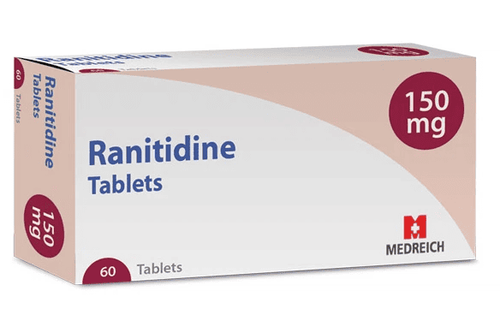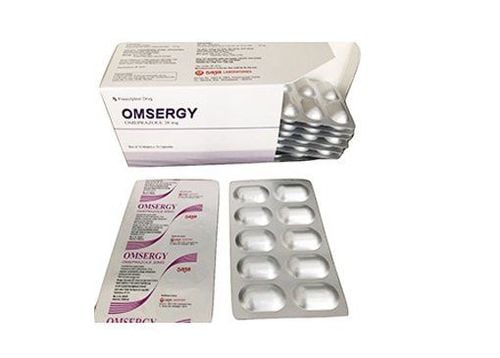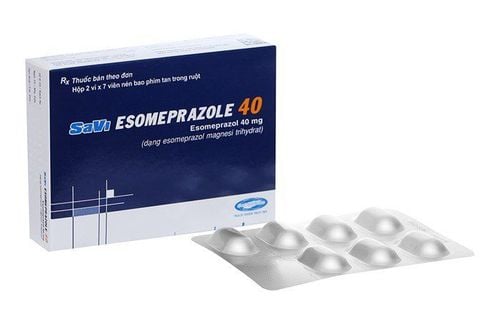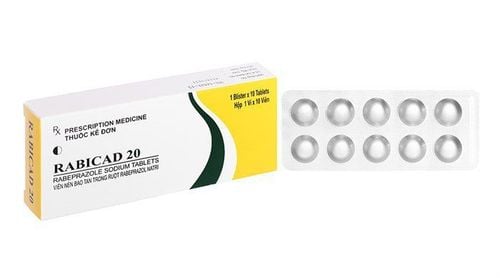This is an automatically translated article.
Acids can irritate, destroy the stomach, cause inflammation, ulcers and other conditions. At this time, the drug Helinzole will be prescribed to help prevent cells in the stomach lining from producing too much acid, supporting the healing process of local damage.
1. What does Helinzole do?
Helinzole contains the active ingredient omeprazole, which reduces the amount of acid the stomach produces. Therefore, Helinzole is used to treat the following conditions:Gastroesophageal reflux disease (GERD): When acid from the stomach escapes into the esophagus causing pain, inflammation and heartburn. Duodenal ulcer or stomach ulcer: Omeprazole may be used to treat this condition or prevent the recurrence of the ulcers. If the ulcer is caused by an infection with the bacteria "Helicobacter pylori," your doctor may also prescribe antibiotics to treat the infection and allow the ulcer to heal better. Ulcers Caused by Non-Steroidal Anti-Inflammatory Drugs (NSAIDs): Omeprazole can also be used to prevent ulcer formation if you are taking NSAIDs. Increased amount of excess acid in the stomach (Zollinger-Ellison syndrome).
2. Things to know before taking Helinzole
Do not take Helinzole if:
You are allergic (hypersensitive) to Omeprazole or any other ingredient of the medicine. If you are allergic to medicines that contain other proton pump inhibitors eg Pantoprazole, Lansoprazole, Rabeprazole, Esomeprazole. If you are taking any medicine containing nelfinavir (to treat HIV infection). Talk to your doctor or pharmacist before taking Helinzole if:
Have reduced body stores or risk factors for vitamin B12 deficiency and need to be treated with Helinzole long-term. This is because Omeprazole may decrease the absorption of vitamin B12. Have had a skin reaction after being treated with a medicine similar to Omeprazole or medicines that reduce stomach acid. If you develop a skin rash, especially in sun-exposed areas, tell your doctor as it may be necessary to stop treatment with Omeprazole. Because Helinzole or Omeprazole can mask the symptoms of other medical conditions, if any of the following happen before you start taking it or while you're taking it, talk to your doctor right away if:
Have a lot of weight loss for no reason accompanied by difficulty swallowing; Have an upset stomach or indigestion; Start vomiting food frequently or if you notice that your vomit is bloody or looks like coffee grounds; Black or bloody stools; Have serious liver problems. Taking a proton pump inhibitor such as Helinzole, especially for a period of more than one year, may slightly increase the risk of fracture of the hip, wrist, or spine. So tell your doctor if you are at risk for osteoporosis or are taking corticosteroids at the same time.
3. How to use Helinzole?
Always take Helinzole exactly as your doctor or pharmacist has prescribed. Check with your doctor if you are unsure.
The doctor will tell the patient how many tablets to take a day and for how long. This will depend on the patient's condition and age.
To treat symptoms of GERD such as heartburn and acid reflux:
If your doctor finds that your esophagus has been mildly damaged, the recommended dose is 20 mg once daily for 4-8 weeks. Your doctor may order a dose of 40 mg for the next 8 weeks if the mucosal wound has not healed. The recommended dose once the wound has healed is 10 mg once daily but can be increased to 20 mg to 40 mg once daily. For the treatment of duodenal ulcers:
The recommended dose is 20 mg once daily for 2 weeks. Your doctor may order the same dose of medication for another 2 weeks if the ulcer still hasn't healed. However, if the ulcer has not completely healed, the dose may be increased to 40 mg once daily for 4 weeks. For the treatment of stomach ulcers:
The recommended dose is 20 mg once daily for 4 weeks. Your doctor may order the same medication at the same dose for another 4 weeks if the ulcer still hasn't healed. However, if the ulcer has not completely healed, the dose may be increased to 40 mg once daily for 8 weeks. To prevent recurrent duodenal ulcer:
The recommended dose is 10 mg or 20 mg once daily. Your doctor may increase your dose to 40 mg once a day. To prevent recurrent peptic ulcers:
The recommended dose is 20 mg once daily. Your doctor may increase your dose to 40 mg once a day. For the treatment of duodenal and gastric ulcers caused by NSAID use:
The recommended dose is 20 mg once daily for 4 to 8 weeks. To prevent stomach and duodenal ulcers if you are taking an NSAID:
The recommended dose is 20 mg once daily. To treat peptic ulcers caused by Helicobacter pylori infection and prevent recurrence:
The recommended dose is 20 mg twice daily for 1 week or 40 mg once daily for 1 week. In addition, the regimen for eradicating Helicobacter pylori requires a combination of antibiotics such as Amoxicillin, Clarithromycin and Metronidazole or Tinidazole. For the treatment of too much acid in the stomach caused by an overgrowth of the pancreas (Zollinger-Ellison syndrome):
The recommended dose is 60 mg per day. The doctor will adjust the dose depending on the patient's needs and decide how long to take the medicine. If your doctor recommends taking more than 80 mg per day, divide the dose and take it twice a day. Regardless of the indication, if this drug is used once a day, it should be taken in the morning and 30 minutes before meals for optimal acid suppression. Swallow the tablet whole with half a glass of water. Do not chew or crush the tablets, because the tablets contain coated tablets, which prevent the medicine from being broken down by the acid in your stomach.
If you accidentally take more Helinzole than prescribed by your doctor, tell your doctor. Usually, taking a high dose of Omeprazole once does not cause any harm, but a small number of people may experience symptoms such as nausea or vomiting, dizziness, stomach pain, diarrhea, headache, lethargy, or dizziness. slow.
If you forget to take a dose of Helinzole or Omeprazole, take it as soon as you remember. However, if it is almost time for the next dose, skip the missed dose, do not double it.
During treatment, it is necessary to avoid voluntary discontinuation of Helinzole or Omeprazole even if the symptoms have improved. Damage to the gastrointestinal tract may not be completely healed and may recur if the necessary course of treatment is not completed.
4. Possible side effects when taking Helinzole
Like all other medicines, Helinzole can cause side effects. If you notice any of the following rare but serious side effects, stop taking the medicine and contact your doctor:
Allergic reaction to the medicine. Redness of the skin with blisters or peeling and bleeding in the lips, eyes, mouth, nose, and genitals. This could be Stevens-Johnson syndrome. Severe liver problems leading to inflammation or failure of the liver, hepatic encephalopathy. Decreased red or white blood cells, platelets, causing infection, fever, weakness, easy bruising and bleeding, sore throat/throat/mouth. Serious kidney problems. Inflammatory bowel disease with signs such as pain and bloating, nausea. Skin rash, which may be accompanied by joint pain. Other possible Helinzole side effects:
Headache. Digestive disorders such as diarrhea, stomach pain, constipation, flatulence, slow digestion. Swollen feet and ankles. Insomnia. Dizzy. Broken hip, wrist or spine. Dry mouth. Hair loss. Vitamin B12 deficiency. In summary, Helinzole is used to treat and prevent damage to the gastrointestinal mucosa through the mechanism of reducing the amount of acid produced by the stomach. In order to achieve effective treatment, in addition to using drugs, patients also need to have a scientific diet, avoid skipping meals, reduce stress and do not use alcohol.
Please dial HOTLINE for more information or register for an appointment HERE. Download MyVinmec app to make appointments faster and to manage your bookings easily.













